Before I get into my review of the 2014 Mitsubishi Lancer Evolution X GSR, I want to first explain to all of you a little about myself and a little bit about this review considering the fact that this awesome high performance sedan is in its final days.
Since I was old enough to drive and race cars (legally), I have been fortunate to own at least one high performance American car packing a powerful V8 engine and to this day, I still own two cars and two trucks parking V8 engines with at least 400 horsepower. As a V8 owner and racer, it was almost bred into me to look down upon those folks racing 4-cylinder powered vehicles but unlike many American muscle car owners, I am not someone who takes such exception to non-V8 performance cars. In fact, I spent some time driving and racing an all wheel drive turbocharged Plymouth Laser so while many of my V8 driving counterparts were grumbling about the non-V8 class at the drag strip, I often had a car in that class. While many of my friends sneered at high performance compact sedans like the Subaru WRX STI, the Dodge Neon SRT4 and the Mitsubishi Lancer Evolution, I’ve always been impressed by the performance capabilities of these built up “economy cars” so when it was announced that the mighty Mitsubishi Evolution would meet its demise after the current generation, it was disappointing to learn that such an impressive performance car would be disappearing from the American market. While my friends cheered at the fact that an import performance car was being forced out of production, I was bummed to learn that the Evo wouldn’t see an eleventh generation.

Now, it should be noted that Mitsubishi isn’t exactly killing off the Evo as it will continue for at least one more model year, but the struggling Japanese automaker has made it all but official that it is only a matter of time before the Evo has disappeared from the new car landscape in America and around the world. Even as rising fuel prices help to push younger gear heads towards those performance models with smaller engines that offer better fuel economy capabilities, the downward spiral by Mitsubishi towards being a company that focuses on crossovers and electric vehicles simply leaves no space for the likes of the Evo in their lineup.
In short, while the Mitsubishi Lancer Evolution isn’t dead yet - the emphasis is sadly on “yet.”

Based on the ongoing discussions about the ill-fated future of the Evo, I jumped at the opportunity to spend some time driving the all wheel drive, turbocharged Lancer. Unfortunately, it seems all but certain that this would be my final chance to get some seat time in a brand new Evo so even with my deep roots in the world of American V8 performance, I was looking forward to a week of driving the rally inspired performance car one last time. As has been the case with the Evo IIIV and Evo IX, the Evolution X was quick to illustrate exactly why this car has proven to be so popular in many different forms of racing around the world.
Unlike my normal reviews that look at the exterior and interior aesthetics of a vehicle along with a rundown of the crucial driving dynamics, this piece will focus on all of the amazing performance attributes of the Evo from the perspective of one man who has spent literally his entire driving life behind the wheel of a high performance V8. I don’t love this car because Im an “import guy” or because I insist on liking the underdog like so many automotive journalists. Instead, I love this car because it is one of the last great driver’s cars. The Evo doesn’t pack a lot of high tech junk inside that you don’t need, but it has everything that it needs to be one of the best performance cars in the world even though it isn’t one of the most powerful.
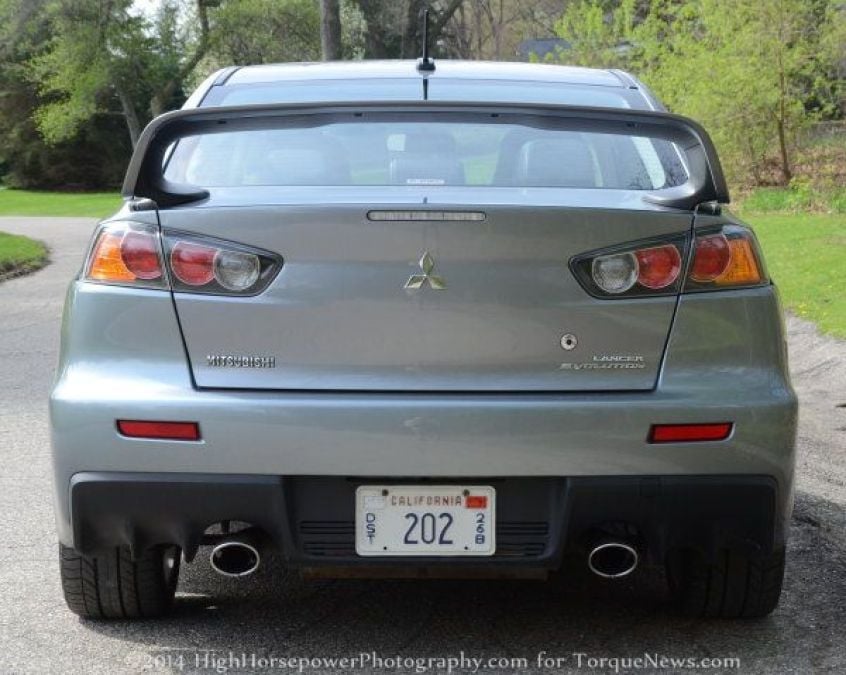
The Cockpit
The 2014 Mitsubishi Lancer Evolution X isn’t going to blow you away with a bunch of high tech gadgetry. Yes, my test car did come equipped with the optional Rockford Fosgate sound system that belts out the tunes which is controlled by the also optional touch screen interface, but that stuff is really just unnecessary filler. Don’t get me wrong - I love the sound system and the big touch screen - but it really doesn’t make the car that much better since the real luster of this car is the drive. There arent a million gauge scattered across the dash to display things like boost or oil pressure, just two large analog gauges that display RPM and speed - the only things that really matter here.
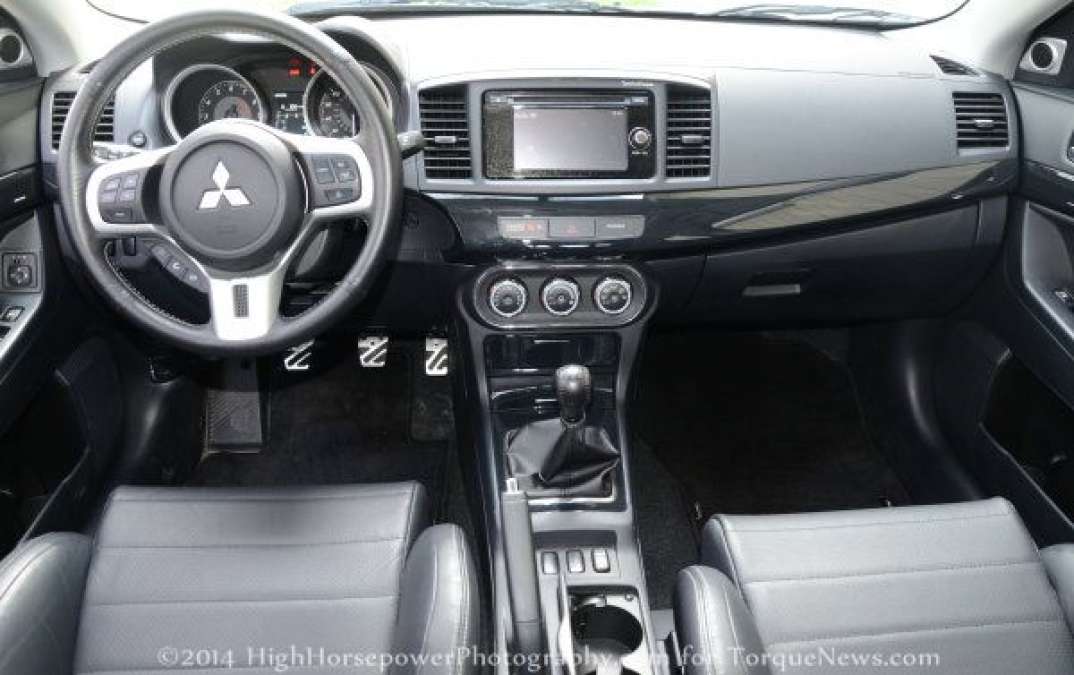
What the Evo does, is a set of Recaro front seats that cushion and cradle both the driver and passenger during the hardest cornering over the biggest rally jumps while also looking awesome and being quite comfortable. Ive driven a bunch of cars with factory Recaro seats now and I would put the comfort and support level of the Evo’s seats towards the top of the list. Some factory race inspired seats are just too tight to fit everyone’s frame, but the Evo seats keep you snugly in place but they do so without crushing the hips of larger drivers and passengers.
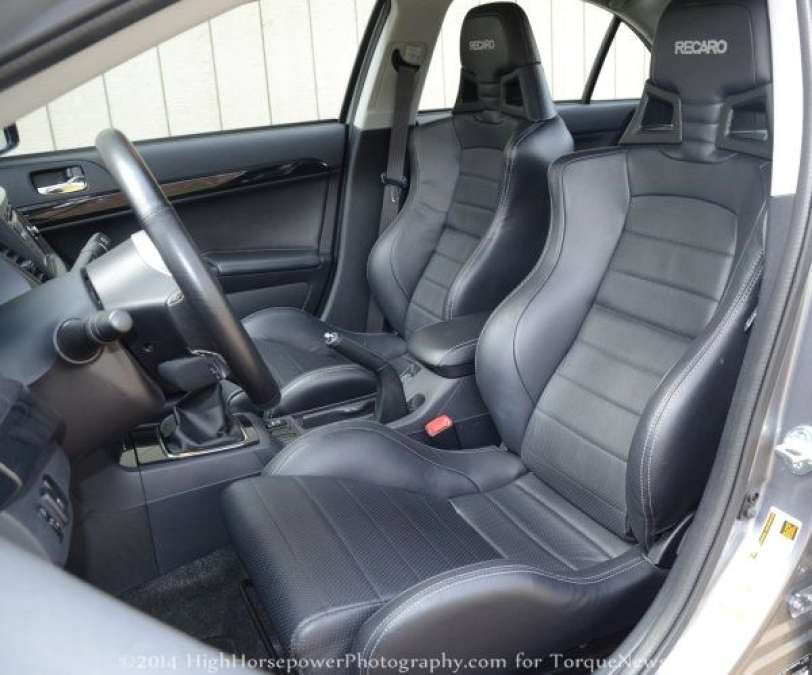
As compact sedans go, the 2014 Mitsubishi Lancer Evolution offers a solid amount of space for the driver and both front and rear passengers. If you have a very tall driver and front passenger, the leg space for the rear riders can get a little tight, but with the front seats adjusted to comfortably seat two 6 foot tall adults, there was adequate room for similarly tall people in the back. Now, I wouldn’t drive across the country with four 6 foot tall adults, but you can arrange the seats in a way that will keep four adults comfortable for the average trip across town.

Most importantly, everything inside of the 2014 Mitsubishi Lancer Evolution X is well within the reach of the driver so whether you are shifting gears or adjusting the radio station, your hands don’t stray far from the steering wheel. The Evo puts you in a driving position that caters to seeing your surroundings without having to move around much in those lovely Recaro buckets. There is also plenty of space in the truck for a car of this size, but I wouldn’t suggest putting anything back that there you don’t want sliding around - because when you get to hammering the throttle that stuff will start sliding around.
The Motivation to Fly
My 2014 Mitsubishi Lancer Evolution test car was fitted with the GSR trimline which means that the 291 horsepower turbo 4-cylinder engine sends that power and 300lb-ft of torque to all four wheels by means of a 5-speed manual transmission. With the high horsepower numbers reached by the likes of the Dodge Challenger, Ford Mustang and Chevrolet Camaro, 291 horsepower doesn’t sound like a particularly lofty figure, but in this relatively svelte body, that power and torque makes for one very quick little sedan. At just a shade over 3,500lbs, the Evo GSR has a fairly impressive power to weight ratio, but what makes it so impressive in pretty much any driving situation as the advanced all wheel drive system.
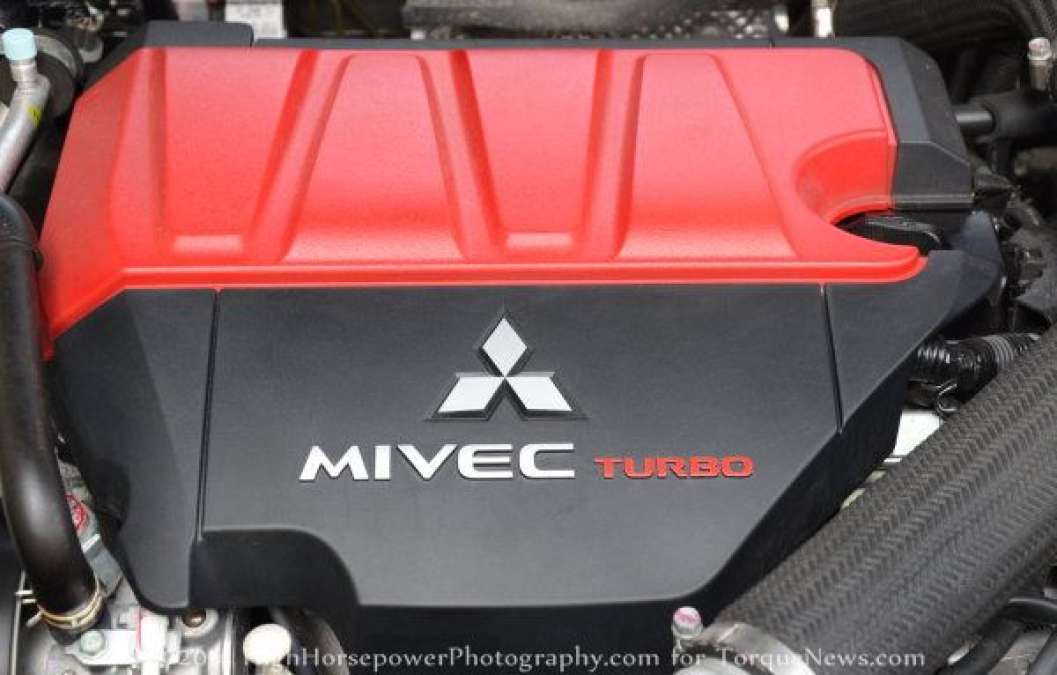
Mitsubishi calls their system the S-AWC for Super All Wheel Control and no matter what type of surface you are on, the this advanced all wheel drive system makes good on its promise. Whether you are launching from a stop or simply accelerating hard through the mid range, the S-AWC system guarantees that every bit of power sent to the wheels is used for forward thrust. While launching the Evo X hard on tarmac (as when drag racing or outrunning someone from a stop light) takes a bit of practice to really get away in a hurry, traction is never, ever an issue. Launching on solid footing too hard may bring about a touch of bog which is intensified by boost loss in the right circumstances, but a little experience in getting the Evo away from the line will allow you to come out with as much throttle input as you like. Unlike your rear wheel drive performance cars that will roast the tires if you launch too hard; the Evo responds beautifully to a good, hard, high RPM launch.
What Boost Lag?
Speaking of boost, a great many modern turbocharged cars can take a second to get up to power due to the need for the turbocharger to get spinning to the proper speed - a situation which is commonly referred to as boost lag. In the Mitsubishi Lancer Evolution X, boost lag is little more than a myth. No matter how hard you let’er rip, the turbo spools up instantly and away you go. An experienced racer might notice a touch of this delay, but the average joe experiences nothing but “holy crap” acceleration. The 5-speed manual transmission, which is unique to the Evo GSR, gives you a great feel for the working of the transmission as you slam from gear to gear and unlike some sports cars that make it challenging to get through the gears in a hurry - the Evo is wonderfully simple to shift very, very hard. In both up shifting and downshifting, the Evo manual transmission gives you the feeling and control that a proper sports car should provide with no real downside and this is true under both hard acceleration and basic everyday driving. The clutch is as stiff as you would expect and that adds to the sport feel of this 4-door turbocharged beast.

A Rally Car for Road Use
Best of all, the same performance that you will experience when driving on paved roads transfers over perfectly to offroad driving so on both gravel roads and muddy roads, the Mitsubishi Evo packs the same high speed fun as it does on the road. The Metro Detroit area is plagued with miserably unpaved roads that I typically avoid with anything other than 4WD trucks and SUVs, but the Evolution’s rally pedigree allows it to handle these rough roads with ease; both in terms of handling and acceleration. The same suspension setup that offers a stiff yet surprisingly comfortable ride on the highway takes the bumps and ruts of these unpaved roads like no car Ive ever tested. You can ease along these roads with no concerns, but you can also blast down these roads and the suspension system just eats up the bumps. Don’t get me wrong - you can still feel the rough road underneath you, but you wont have the bumps jarring you around in the car, nor will the Evo bounce out of control like a “normal” performance car. Also, thanks to the S-AWC all wheel drive system, you can put lots of power to the unpaved roads with enough confidence to reach speeds that would have other cars crumbling to bits without any real concern of traction problems. Turn off the traction control system and the Evo will allow you to do your best Global RallyCar driver impersonation with the wheels spinning as you dirt through the dirt - all without really ever losing control.
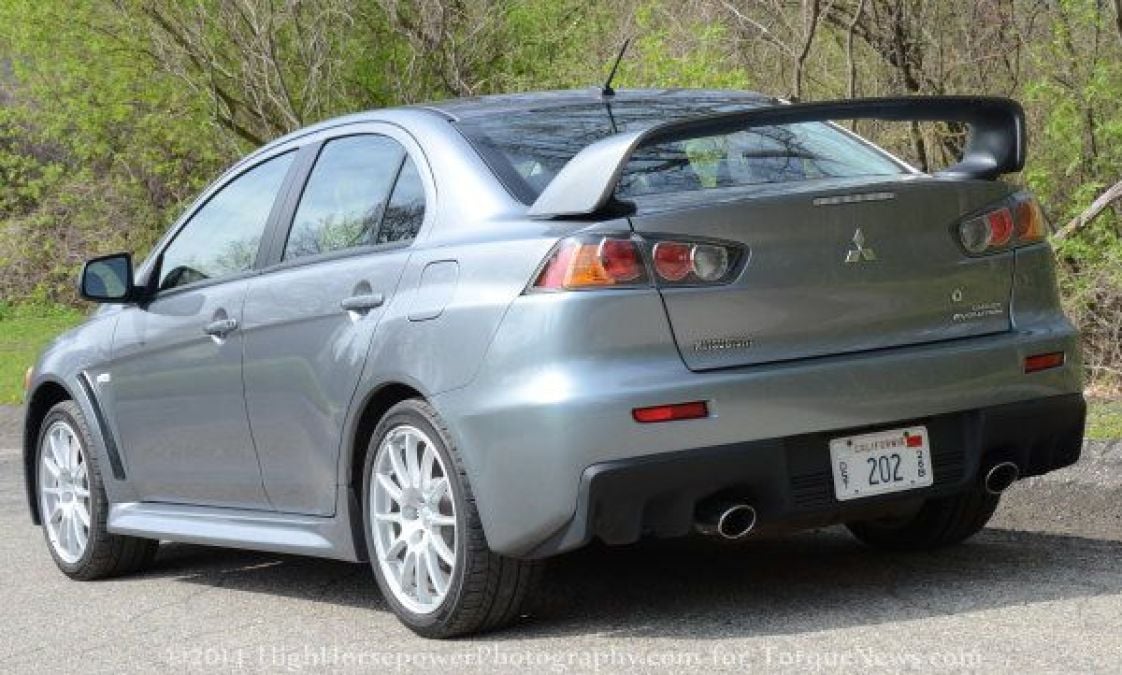
This car was designed to race on rough dirt roads, and that shines through when driving the Evo on such a road, but the Mitsubishi engineers did a remarkable job of designing the suspension system to handle unpaved roads while still offering awesome on-road handling.
Road Handling Like Few Cars
As mentioned above, the on-road ride of the 2014 Mitsubishi Lancer Evolution X GSR is stiff, but not to the point of being unpleasant for your passengers so this is a car that you can use to get your friends or family around town without your grandmother complaining that the car is beating her up. I expected the Evo to handle very well on road and off - and it does - but it also provides a far more comfortable ride under non-performance driving circumstances than I would have imagined. Mind you, there is some obvious trade off when you have a car that handles so well on pretty much any driving surface, but the stiffness of the suspension and chassis transforms into far less harshness than a great many other sports cars sold in America. This suspension/chassis setup combined with the all wheel drive system allows you to push the Evo far harder through a turn much harder than you could any of the popular rear drive sports cars and when you do reach the limits of the standard Yokohama tires, the car will simply being to slide (under steer) before it will swing the back end out. Because of this, Evo drivers have a big advantage over slightly quicker rear drive cars in any race that has turns as you can go through and come out of turns harder and sooner than you can with a similarly quick rear drive car.

One complaint that I had with the Evo - really my only complaint with the driving dynamics of the turbocharged Mitsbishi - is that the super aggressive gearing makes for a screamer on the highway. Around Metro Detroit, the highway speed limit iss usually 70 miles per hour and when cruising at those speeds, the engine is running at a very high RPM - enough so that when I first started driving the Evo X GSR, I kept looking to check and see if I was still in fourth gear. The engine screams pretty much all of the time when cruising at those speeds, but when the need comes to hammer down and blast to speeds well beyond those posted limits…the Evo is once again quick to happily do so. However, because of those extremely high RPMs on the highway, I would like to see a sixth gear but I don’t want that extra gear enough to sacrifice the manaul shifting and pick the Evo MR (which only comes with a 6-speed automatic transmission). Fortunately, the Evo handles so beautifully that I frequently found myself picking twisty side roads rather than the highway just because the car is so much fun to push through the turns. That being said, if you spend a whole lot of time driving on the highway at similar speeds, be prepared to listen to the engine’s high RPMs all of the time…but that is a very small price to pay for all of the upsides to the Evo drive train.
Although the high RPMs at highway speeds are a bit disconcerting, the Mitsubishi Lancer Evo X GSR really has no shortcomings in terms of driving dynamics. Whether you are into road racing, drag racing, rally racing, autocross or just plain driving fast on the open road - this is a sports car that can truly do everything very well. The Evo might not pack the same “wow factor” or the big power numbers as some of the other performance cars in the American market, but the positive far outweigh the negatives of the Evo X.
The Final Word
Most of my reviews end with a “final word” that will likely be followed up in the future by another review of a newer model of that same car but unfortunately, this will likely be the last time that I review a brand new Mitsubishi Lancer Evolution. The odds seem very good that there will be no Evo XI, but prospective buyers still have at least the remainder of the 2014 model year and the 2015 model year to snatch up one of the last of an incredible breed of sports car.
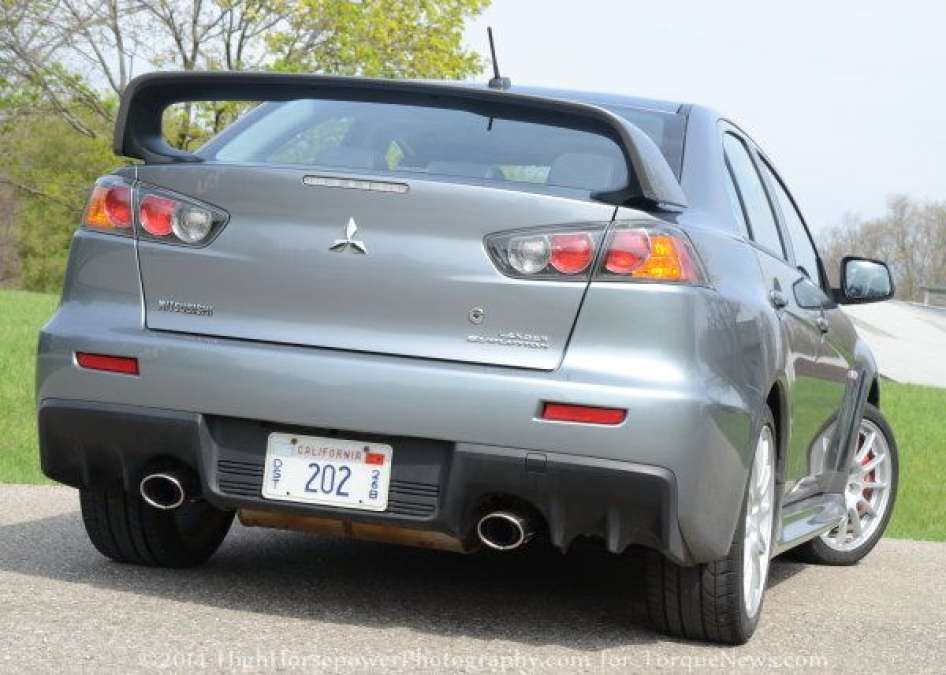
When considering the Evo X, you should ask yourself a few questions. Do you put performance before anything else? Do you want to be able to go very fast in any condition? Do you want to be able to participate and be competitive in pretty much any type of auto racing with the same car that you drive every day? If you answered yes to these questions, the Evo is really the only car on the market today that offers all of these qualities so while the price tag is bigger than vehicles like the Mustang or Camaro - the Evo offers access to performance worlds that will never be any more than a dream to owners of those cars. This car offers enough comfort to easily serve as a daily driver, but it can also do what few sports cars on today’s market can do - and that is perform beautifully in literally any performance venue. So if you want a performance car that puts all of the focus on performance and none of the focus on crap that doesn’t matter - the Evo X is the car for you.
As for my time in the Evo X, as this nameplate vanishes from the American performance car landscape, I will never forget my time spent blasting down a dirt road and along the smooth tarmac in one of the most complete all around performance cars ever sold in the world. No matter what you drive or race, you should be disappointed to see the Evo die because it marks the death of one of the true “driver’s cars”.












